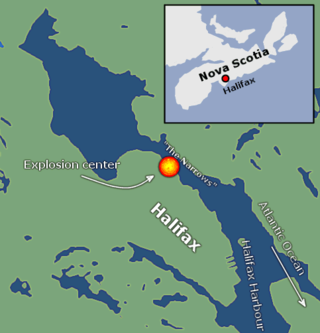Halifax Explosion
|
|
The Halifax Explosion occurred on December 6, 1917, in Halifax, Nova Scotia, when a cargo ship loaded with munitions caught fire and exploded, killing 1,635 people and injuring thousands more.
It was the largest man-made explosion until the first atomic bomb test explosion in 1945 and still ranks as the largest ever man-made non-nuclear explosion. It was also the largest single-day loss of life on North American soil since the 3,600 to 4,800 deaths at the Battle of Antietam (September 17, 1862) in the American Civil War, until the nearly 3,000 deaths of the September 11, 2001 attacks on the World Trade Center and the Pentagon in the U.S.
At 8:45 on the morning of the 6th, the French ammunition ship Mont Blanc and the Norwegian cargo ship Imo collided in the narrows of Halifax harbour. The Mont Blanc was waiting to be let into the harbour on December the 5th, but it arrived late. Halifax harbour had submarine nets that stopped enemy u-boats from entering. This also stopped other ships from entering. At the same time, the Imo wanted to get out of the harbour, and it too was late. On December 6th, the Imo was going to go out in the Right Channel, but another ship was blocking its path, so it went to the left channel. The Mont Blanc was entering via the left channel, and both refused to move. Finally, the Mont Blanc decided to pass the Imo and go into the center. The Imo then stopped altogether, but the backward action of the propellers brought the Imo to the center, and they collided. The Imo then tried to pull back, and sparks ignited, setting the Mont Blanc on fire.
Vapours from the benzol, which was stored on the deck of the Mont Blanc, had spilled over the side and was set afire by sparks from the collision. The Mont Blanc was shipping large quantities of munitions to Europe, which was in the midst of World War I. The hold contained over 2,700 short tons (2,400 metric tonnes) of explosives, including TNT, guncotton, and picric acid. As the fire spread it blocked the crew from reaching fire-fighting equipment and they quickly abandoned ship upon the Captain's orders. Fleeing in two rowboats the crew reached safety on the Dartmouth shore as the burning ship continued to drift toward the Halifax shore.
Mont Blanc cargo:
- 5 short tons (4.5 t) of benzol
- 300 rounds of ammunition
- 122,960 pounds (55.770 t) of gun cotton
- 4,600,000 pounds (2,090 t) of picric acid (explosive)
- 4,661,794 pounds (2,114.554 t) of TNT
At 9:04:35 a massive explosion ensued. The Mont Blanc was instantly fragmented, with much of it vaporising in the giant fireball that rose over a mile into the air. Over 2.5 km² of Halifax were levelled and windows were shattered as far as Truro, Nova Scotia, 100 kilometres away. An anchor from the Mont Blanc was found five kilometres from the harbour. The disaster resulted in approximately 1,635 deaths (as many as 1,000 died instantaneously), nine thousand injured (six thousand seriously) and, according to one conservative estimate, roughly 30 million dollars in damage. 325 acres (1.3 km²) of urban/town area was destroyed, leaving 1,500 homeless. A detailed estimate showed that of those killed, 600 were under the age of 15; 166 were labourers; 134 were soldiers and sailors; 125 were craftsmen; 39 were workers for the railway. Many of the wounds were also permanently debilitating, with many people partially blinded by flying glass. The large number of eye injuries led to great efforts on the parts of physicians, and a collaborative effort managed to greatly improve the treatment of damaged eyes.
The following day a blizzard hit the city, crippling recovery efforts. Immediate help rushed in from around New Brunswick, Prince Edward Island and Newfoundland. In the following week more relief from North America arrived and donations were sent from around the world. The most celebrated and most complete effort came from the Boston Red Cross and the Massachusetts Public Safety Committee. To this day, the citizens of Halifax still donate a large Christmas tree to Boston each year. The friendship also explains why even today many Nova Scotians are Boston Bruins and Boston Red Sox fans.
Much local folklore has stemmed from this event. One tale includes that of a window on the leeward side of the harbour in St. Paul's Church in Parade Square. The hole made in the window by the explosion resembles the bust of a priest. A piece of debris from the disaster is still embedded in the foyer wall above the entrance to the sanctuary. One of the most noted heroes of the day was Vince Coleman, who abandoned his chance to survive by returning to his telegraph office to warn two incoming trains of the impending explosion. Although he was killed in the blast, the trains received the warning and stopped in a safer area and then relayed the message to summon outside help.
The explosion and aftermath were the inspiration for Hugh MacLennan's novel Barometer Rising and Robert MacNeil's novel Burden of Desire.
Prior to the Halifax Explosion, the 1887 Nanaimo mine explosion was the largest man-made explosion in the world.
External links
- Halifax (http://www.thecanadianencyclopedia.com/index.cfm?PgNm=TCE&TCE_Version=A&ArticleId=A0003534&MenuClosed=0)
- Map of Halifax as it existed in 1915 available in "The Atlas of Canada" archives (http://atlas.gc.ca/site/english/index.html)
- Halifax Explosion (http://www.halifaxexplosion.org/)
- CBC: Halifax Explosion (http://www.cbc.ca/halifaxexplosion/)
- CBC Archives: Halifax Explosion (http://archives.cbc.ca/IDD-1-70-971/disasters_tragedies/halifax_explosion/)
- Link to Museum on Halifax explosion (http://museum.gov.ns.ca/mma/AtoZ/HalExpl.html)
- Canada National Archive on Halifax Explosion (http://www.collectionscanada.ca/education/firstworldwar/05180202/0518020203_e.html), with a map detailing on the Ground Zero of the explosion and the city
- Heritage Minutes: Halifax Explosion (http://www.histori.ca/minutes/minute.do?ID=10203)he:פיצוץ הליפקס
Media on the Halifax Explosion
- The Irish Chain (http://www.amazon.com/exec/obidos/tg/detail/-/0006392156/qid=1114960650/sr=8-1/ref=sr_8_xs_ap_i1_xgl14/102-5227622-3472153?v=glance&s=books&n=507846) by Barbara Haworth Attard. [Fictious novel]
- City of Ruins (http://www.cbc.ca/documentaries/cityofruins.html) [A CBC Documentary]
- Shattered City (http://www.cbc.ca/shatteredcity/) [A CBC Mini-Series]

